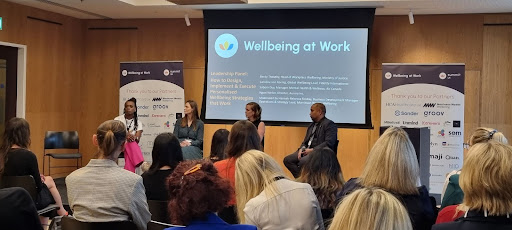Our People and Culture Manager, Jacqueline Smith, attended this year’s Wellbeing at Work Summit in London, and was joined by other experts in the industry, sharing their insights and key developments happening in the world of workplace wellbeing.
She shared with us her key takeaways and the recurring themes from day one of the event.
Wellbeing is a key ingredient for human performance
Sir John Kirwan, Co-Founder of Groov, an employee wellbeing app, perfectly encapsulated why there’s a growing push for wellbeing in the workplace: “The world is starting to realise that wellbeing is a key ingredient in human performance”. In wider culture, mental health and wellbeing has become a hot topic over the last decade, boosted in part by the Covid pandemic where many of us became more self aware, discovering what makes us happy, healthier and more supported. We’ve started to see this shift appear in the workplace too. According to a CIPD Health and Wellbeing at Work survey, 70% of companies state employee wellbeing is on their senior leaders’ agendas.
In wider culture, mental health and wellbeing has become a hot topic over the last decade, boosted in part by the Covid pandemic where many of us became more self aware, discovering what makes us happy, healthier and more supported. We’ve started to see this shift appear in the workplace too. According to a CIPD Health and Wellbeing at Work survey, 70% of companies state employee wellbeing is on their senior leaders’ agendas.
Businesses are starting to recognise it’s their responsibility to look after their employees – although there’s still a way to go when it comes to implementing strategies that genuinely show a sense of care for employees.
Many peers at the conference shared a sense of frustration that wellbeing strategies can often be seen as merely a “tick box exercise” and that convincing leaders to prioritise employee wellbeing is no easy task. In fact, Sarah Cunningham, Managing Director at World Wellbeing Movement, dedicated her whole presentation to arming the audience with the latest data and evidence for getting leadership on side.
Emphasis was placed on the impact that happiness at work had on an individuals performance, productivity and project success. Ultimately, having good employee wellbeing directly and positively impacts revenue: this evidence simply can’t be ignored. Workplace Wellbeing: The Evidence We Cannot Ignore with Sarah Cunningham, Managing Director, World Wellbeing Movement
Workplace Wellbeing: The Evidence We Cannot Ignore with Sarah Cunningham, Managing Director, World Wellbeing Movement
She argued that people managers should be measuring their wellbeing efforts through engagement surveys and obtaining employee feedback regularly and consistently. Having these metrics visible to leadership teams – alongside views of performance and revenue – helps to paint a clearer picture of the correlation between the two.
Workplace wellbeing: from commitments to action
Much like greenwashing, companies are at risk of wellbeing washing: this is when businesses appear to care about the subject of mental health and wellbeing rather than actually taking care of their employees. You can do all the listening and create as many feedback surveys as you want, but real change comes when you do something about it.
A recent study by Claro Wellbeing highlighted the gap between words and actions: 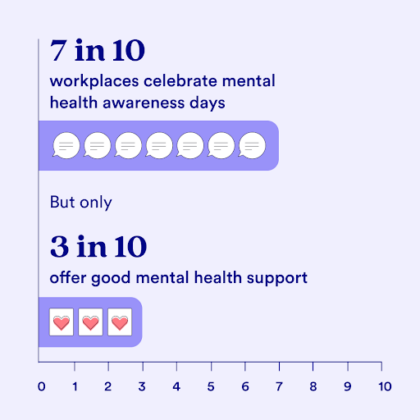 More than a third of employers are wellbeing washing.
More than a third of employers are wellbeing washing.
The issue lies within responsibility. HR and People Managers are finding it difficult to convince wider teams of the importance of employee wellbeing. Getting leadership on board is one thing, but the trick is to permeate the entire organisation. There needs to be a strategic focus on winning hearts and minds across various levels of the organisation. In an agency context, this includes everyone from directors and managers, to delivery teams and specialists.
One proven tactic is to take everyone in the business on that journey. Vicky Bawa, Head of DEI at BAE Systems recommended you need to be honest in the fact that your wellbeing initiative is a journey. Be transparent around its infancy and acknowledge there’s a long road ahead. Give teams the opportunity to contribute to the overall company vision and make the wellbeing strategy something that everyone in the business helped to build and actualise.
Sunaina Kohli, Global DEI Lead at ASOS, shared a rather poignant point: “Wellbeing policies should be as individual as your company culture – so much so, employees can see their fingerprints on it.”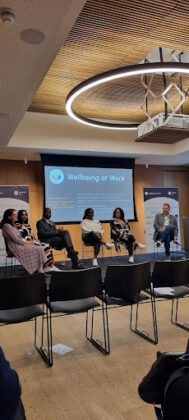 Panel Discussion: Diversity, Inclusion and Belonging From Commitments to Action. Vicky Bawa, Marcia Williams, Dr Kavita Powley, Mo Kebbay, and Sunaina Kohli. Moderated by Chris Cummings
Panel Discussion: Diversity, Inclusion and Belonging From Commitments to Action. Vicky Bawa, Marcia Williams, Dr Kavita Powley, Mo Kebbay, and Sunaina Kohli. Moderated by Chris Cummings
Managers have a responsibility to look after the wellbeing of individuals in their team as this will have a direct impact on the performance and success of their team. Ngozi Weller, Inclusivity Director at Aurora Wellness Group rightly pointed out: “It’s the manager’s job to help an individual do their job to the best of their ability – this includes the mental health and wellbeing of that individual.” 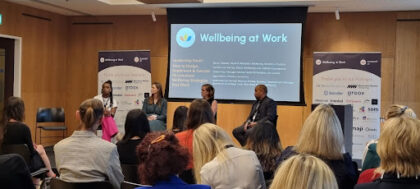 Leadership Panel Discussion: How to Design, Implement & Execute Personalised Wellbeing Strategies that Work. Becky Thoseby, Caroline von Koenig, Sobora Duy and Ngozi Weller. Moderated by Hannah-Rebecca Findlay
Leadership Panel Discussion: How to Design, Implement & Execute Personalised Wellbeing Strategies that Work. Becky Thoseby, Caroline von Koenig, Sobora Duy and Ngozi Weller. Moderated by Hannah-Rebecca Findlay
Employee wellbeing should be embedded into all processes, including job specifications and professional relationships. While it’s down to the People Managers to get everyone on board and integrated within wellbeing management from the beginning, wellbeing should evolve to become a shared responsibility of each and every colleague in the business.
Intersectionality and the importance of a tailored approach
The final theme that was strongly present at this year’s Summit was the need for a tailored approach to individual preferences and experiences when it came to offering employees wellbeing support – particularly in the mental health space with programmes such as therapy and counselling.
Dr. Cristy Leask, Head of Therapies, HCA Healthcare spoke about the need to adapt to different personality types and learning preferences in order to effectively offer support: “Every person has their own full story encompassing so much detail that another person can never truly appreciate. Each conversation serves as just a snapshot into their lived experience.”
Although as a friend, family member or indeed, an employer, we cannot fully comprehend what it is like to be anyone else, we can seek to further understand a person by listening carefully, dedicating time and focusing our energies to the individual perception. Recognising feelings, thoughts and behaviours can change over time. Any one person has a past, present and importantly numerous possibilities for their future. Wrapped up in all this is a persons working life and career and the ways in which they can develop, progress and grow.
Marcia Williams, Executive Director of Inclusion for Channel 4 shared: “To be a responsible, progressive employer you need to understand and support the complexities of real people’s lives and help them navigate it. Listen to people and recognise that everyone is part of their own wider story”.
With every area of mental health and wellbeing, People Managers should consider added layers of intersectionality. According to the Oxford Dictionary, intersectionality is: “the interconnected nature of social categorisations such as race, class, and gender as they apply to a given individual or group, regarded as creating overlapping and interdependent systems of discrimination or disadvantage”.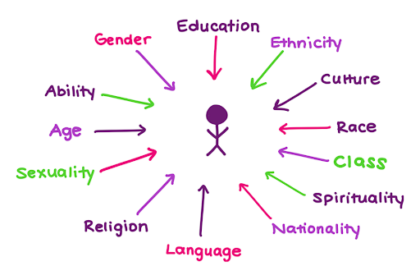 Intersectionality is widely used to illustrate the interplay between discrimination, whether it’s based on gender, race, age, class, sexual identity, religion, or more. Image credit: IWDA
Intersectionality is widely used to illustrate the interplay between discrimination, whether it’s based on gender, race, age, class, sexual identity, religion, or more. Image credit: IWDA
It’s important to invest in education and training for employees in this area, broadening horizons and teaching about the experiences of people who are different to ourselves. Through the lens of intersectionality we can better acknowledge the differences between us.
Workplaces should extend opportunities for employees to offer their thoughts when something does not fit their experience or if a policy doesn’t reflect their reality. Although it’s important not to place this responsibility into their hands, it’s important to allow a dialogue to open up, but ultimately it’s down to HR and People Managers to grasp and identify intersectionality in the workplace.
A final word
Humankind in the context of our existence has only just begun to discover and explore matters of mental health and wellbeing. Even more so how this plays into our working lives. Employee wellbeing will continue to gain traction and become more and more of a priority for businesses, particularly as it begins to coincide with the realisation that wellbeing directly correlates to high performance and company success.
While the mindset is certainly shifting, there still remains a difficulty for many businesses when it comes to needing professionals implementing meaningful wellbeing strategies and obtaining buy-in from the whole business.

